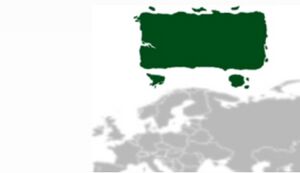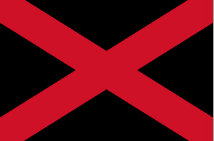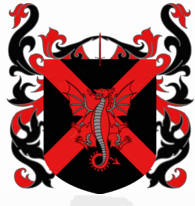Yogania: Difference between revisions
No edit summary |
No edit summary |
||
| Line 25: | Line 25: | ||
|other_symbol_type = <!--Use if a further symbol exists, e.g. hymn--> | |other_symbol_type = <!--Use if a further symbol exists, e.g. hymn--> | ||
|other_symbol = | |other_symbol = | ||
|image_map = <!--e.g. LocationCountry.svg--> [[File:Yoganiamap .jpg|frameless | |image_map = <!--e.g. LocationCountry.svg--> | ||
[[File:Yoganiamap.jpg|frameless]] | |||
|loctext = <!--text description of location of country--> Northern Europe | |loctext = <!--text description of location of country--> Northern Europe | ||
|alt_map = <!--alt text for map--> | |alt_map = <!--alt text for map--> | ||
Revision as of 12:44, 23 December 2022
This article is incomplete because it is pending further input from participants, or it is a work-in-progress by one author. Please comment on this article's talk page to share your input, comments and questions. Note: To contribute to this article, you may need to seek help from the author(s) of this page. |
Kingdom of Yogania Yogoryd Bugarlak (Yoganian)
Royaume de Yoganie (French) | |
|---|---|
| Motto: «Yogoryd Bugarlak Yongur Bulagen» (The Yoganian Kingdom Will Rule Forever) | |
| Anthem: « Gunnar Men» | |
 Yogania (dark green) in Europe | |
| Location | Northern Europe |
| Capital | Koppola (1413-1802) Yocopo (1802-present) |
| Largest | Yocopo |
| Official languages | Buggan Yoganian, Kjersogen Yoganian, French |
| Recognised regional languages | Kjersogen Yoganian (Kjerso), French (Bukjer) |
| Ethnic groups (2018) | 95% White Yoganian 5% Other |
| Demonym(s) | Yoganian |
| Government | Unitary parliamentary constitutional monarchy |
• Monarch | Yogory VII |
• Prime Minister | Gordon Yogner |
• President of Parliament | Ian Bodowil |
• Government Spokesman | Jakob Buckin Woldman |
| Legislature | Yoganian Parliament |
| Senate | |
| Yoganian Assembly | |
| Establishment | |
• Creation of the Yoganian Kingdom | 550 |
• Conquering of Kjerso | 1228-1264 |
• Buggan Empire | 1594-1707 |
| Area | |
• Total | 22,344,677 km2 (8,627,328 sq mi) (1) |
• Water (%) | 7,2% |
| Population | |
• 2022 estimate | 864,320,556 million (3) |
• 2022 census | 864,209,735 million |
| GDP (PPP) | 2021 estimate |
• Total | 9,872 trillion $ (3) |
• Per capita | 55,120$ (17) |
| HDI | very high (2) |
| Currency | Euro (EUR) |
| Time zone | UTC-2, -1, 0, +1, +2, +3, +4 |
| Driving side | right |
| Calling code | +42 |
| Internet TLD | .yo |
Yogania, officially the Kingdom of Yogania (Yogoryd Bugarlak, Royaume de Yoganie) is a country located in the extreme north of Europe. There are about 864 million inhabitants, making it the third most populous country in the world. It is also the biggest country in the world, with 22,344,677 square kilometers. The capital and largest city is Yocopo, with a population of over 34 million inhabitants and is located in the southwest of the country, on the Yocopo River. Yogania is an archipelago consisting of 3 islands: the main, biggest one is called Yogania, the 2 smaller ones are called Byrenyol and Bugareyol. The kingdom was founded in 550 A.D by Yogodan I The Great, and expanded until fully conquering the neigboring kingdom of Kjerso in 1264. Yogania is known worldwide for various things, including it´s music, with popular Yoganian band Klyread reaching international fame, for it´s cuisine, with it´s national dish Burgenal, for it´s automobile industry with successful car companies Golten and Burgess, and for it´s numerous tourist attractions, the most famous ones baing the statue of Burydan Halfdan in Yocopo and the Buganollien Mountains in Bugan. Yogania´s national animal is the Yoganian Red Dragon, it is one of the only countries to have a fictional species as it´s national animal. The highest point in Yogania is Mount Buryatia, culminating to 5668m at it´s summit.
Etymology
The name Yogania comes from the word Yogoryd, itself derived from the Old Yoganian word Yogo-rydden, meaning "Kingdom of Yogodan", in reference to Yogodan I The Great, the first King of Yogania.
History
Prehistory
Archeological evidence shows the island of Yogania has been inhabited since around 9000 B.C. The Baldanjoki cave contains prehistoric tools and drawings that have been estimated to be over 5000 years old. Early humans living in Yogania developed black hair color and pale skin around that time.
Kingdom of Kjerso
Around 170 B.C, Jokelayan The Great proclams himself King of Kjerso, which occupied the whole eastern side of the island. The Kingdom of Kjerso was the first state established in the island of Yogania. It lasted until 1264 A.D when it was conquered by Burydan Halfdan´s army, the king of neighboring Yogania.
Kingdom of Yogania
The Kingdom of Yogania was founded around 550 A.D by Yogodan I The Great. At the time, it only extended to the city of Yocopo and the area around it.
Conquering of Kjerso
Over the years, it expanded until reaching Kjerso´s border, and the 2 countries were constantly battling with eachother, trying to take more land. In 1225, Burydan Halfdan became King of Yogania after Bobigan I died, and he started trying to conquer the entirety of Kjerso. The first few attempts failed, but in 1246, after strengthening his army, Burydan Halfdan began conquering the Kingdom of Kjerso. To try and combat the invasion, Kjerso replaced their king with Yalashi Bogelnod, a renowned military general. In 1264, Burydan Halfdan coquered Bugan, the capital of Kjerso, marking the success of his campaign. Kjerso was promptly integrated into the Yoganian Kingdom. He decided to preserve the language and culture of the Kjerso people, which was not drastically different from the other Yoganians.
Buggan Empire (1594-1707)
In 1594, King Yodolyd VI decided to use his powerful army to conquer the rest of Europe. He renamed the country to the Buggan Empire (Yoganian: Buggan Haltlak) They got down to the south of France and stayed there before they got pushed back by the French army in 1698. The country was renamed back to Yoganian Kingdom in 1707 by Jakob IV.
Industrial Revolution
Yogania was one of the first countries to have steam-powered trains. It was also a big coal producer, with coal mining being a big part of Yogania's economy at that time. The country also experienced a booming population, going from 230 million people in 1844 from 420 million in 1914.
19th Century
In 1879, Jom VIII dies without an heir. Yogodan Yangodi-Yol, a nobleman from Yocopo, is declared King of Yogania by the Yoganian Parliament and is crowned in 1880 as Yogodan XV. This caused a wave of protests across the country ultimately leading to the change of Yogania´s political regime from a semi-constitutional monarchy to a fully constitutional monarchy, reducing the King to a simple figurehead. Yogodan XV is considered one of the better kings of Yogania for contributing to the preservation of the country's traditions and culture.
World Wars
Yogania did not take any sides during WWI, since the country is quite isolated from the rest of Europe and was not really affected by the war. In WW2, Yogania sided with the Allies, and sent soldiers to fight for other countries' armies. Yogania was never bombarded and was one of the few European countries that walked out relatively unscathed from the war.
Second half of the 20th century
Yogania's economy after WW2 was not very diverse, mostly exporting agricultural goods and metals. In the 1960s and 70s, Yogania experienced a booming population again, going from 670 million people in 1961 to 749 million in 1985. From 1980 to 1990, Bjorn Yogun was Prime Minister, the only one to be reelected for a second term. In 1990, King Buckigan VI dies, and is replaced by his son Yogory VII, who is currently still king today.
Politics
Government
Yogania is a constitutional monarchy. The head of state is the King of Yogania, currently Yogory VII. The Head of Government is the Prime Minister, currently Gordon Yogner. Yogania is a very stable country, with a democratic, fairly liberal government, free/cheap healthcare and globally very good infrastructure. The country has a great quality of life and there are relatively few major problems. The country has a multiple party system, the current prime minister is part of the JDS (Jobolin Dyrnan Soderban), a center-right party.
Geopolitics
Yogania has 3 levels of administrative divisions. First there are 3 regions (Yokjer, Bukjer, Kjerso.) Then, 22 states. Finally, 134,140 cities. The capital city is Yocopo, which is also the biggest city with 34 million people. The second and third biggest cities are Burnach and Bugan, with 25 and 20 million people respectively. The most populous state is Buckenryd, with 102,344,220 million people. Yogania is part of the European Union since 1995 and part of the Euro Zone since it's creation.
Geography and Climate
Geography
Yogania has lots of arable land despite being in the extreme north. It is quite flat at the south and middle, very flat near the Burnach (state) area, quite mountainous at the north and southwest with the Buganollien mountains and the Yocopo mountains. 7% of Yogania´s land is covered in forest. The biggest one, located in the northwest, is called the Red Forest (Yoganian/Kjerso: Bard Dagenin French: Forêt Rouge).The very north of Yogania is uninhabitable because of extreme climate. It is covered in snow all year long. Since Yogania is an island country, it doesn´t border any other countries. The closest countries to Yogania geographically are Iceland, Norway, Sweden, Finland and Russia.
Climate
See also: Köppen climate classification
Because of it´s size, Yogania´s climate varies depending on the area, ranging from a hot-summer continental climate (at least one month's average temperature above 22 °C) in the south around the Burnach area, warm-summer continental climate (all months with average temperatures below 22 °C) in the south, subarctic climate (1–3 months averaging above 10 °C) in the middle of the country, extremely cold subarctic climate (coldest month averaging below −38 °C) in the middle-north of the country, and an uninhabitable ice-cap climate (eternal winter)in the very north.
Demographics
Population
According to the 2022 census conducted by the Yoganian Census Bureau, the Yoganian population consists of 864,209,735 million people, which is an increase of 5,9% compared to the 2012 census. Yogania´s population experienced a large-scale increase in population during the last 50 years, going from about 748 million people in 1974 to reaching 800 million in 1991 and reaching 850 million in 2005. The median age of the Yoganian population is 40,6 years and the average life expectancy is of 84,2 years.
Population density
Yogania is quite densely populated for it´s size with a roughly equal distribution of the population in the south, middle and middle-north of the country. The extreme north of the country is uninhabitable because of extreme climate.
Cities
79% of the Yoganian population live in cities and other urban areas. The capital and largest city is Yocopo, with a population of over 34 million people and located in the southwest of the country. There are 6 cities in Yogania with a population higher than 10 million.
Largest Yoganian cities by population
| Rank | City | Population (millions) | State |
|---|---|---|---|
| 1 | Yocopo | 34,895,142 | Yocopo (state) |
| 2 | Burnach | 25,362,900 | Burnach (state) |
| 3 | Bugan | 20,744,240 | Bugan (state) |
| 4 | Dyrden | 15,209,118 | Buckenryd |
| 5 | Hangeul | 13,233,875 | Budlin |
| 6 | Salgon | 11,205,343 | Bugan (state) |
| 7 | Garragan | 9,670,965 | Ordansk |
| 8 | Buckinloden | 7,889,550 | Popi |
| 9 | Koppola | 4,323,095 | Öld |
| 10 | Gungarne | 3,822,238 | Bugan (state) |
Ethnic Groups
See also: Yoganians (ethnicity)
Yogania has always been a very homogenous country. The vast majority (95%) of the population is Yoganian, which are native to the country. The other 5% is composed of various ethnic groups, all issued from the wave of immigration to European countries of the second half of the 20th century. Most of these immigrants are from French-speaking countries because of the presence of the language in Yogania.
Healthcare
Healthcare in Yogania is covered by a tax-funded public healthcare institution, Baggard Yogoryd Daganan, shortened to BYD. It abides by the policies listed in the Yogania Education and Healthcare Act of 1982. It is universal, and every citizen of the country is required to sign up for it by their 20th birthday. It covers healthcare costs based on income, the lower the person´s income is, the more costs it covers.
Languages
Yogania is divided between 3 regions (west to east) Bukjer, Yokjer, Kjerso. In Bukjer, people primarily speak French except for the state of Popi, in the northwest. It’s the least spoken language in the country with around 208 million speakers. The city of Yocopo has signs in three languages but most of the city’s population speaks French. In Yokjer, people speak Buggan Yoganian, also called Standard Yoganian, which is the most spoken language in the country with about 330 million speakers. Lastly in Kjerso people speak Kjersogen Yoganian, often just called Kjerso, which is a language related to Buggan Yoganian but is different. There are around 220 million people who speak Kjerso.
Culture
Clothing
The traditionnal Yoganian dress is called Burgol (Yoganian) or Burjok (Kjerso). Burgol is an abbreviation of "Burlak Golstin" while Burjok is an abbreviaton of "Burlak Jokhan", both meaning "King´s clothes" due to it being long associated with royalty and other nobles. Burgol/Burjok for men consists of a pair of pants, a button down shirt (always white), a tie, a vest, a long overcoat reaching to the back of the knees, and a Burgol/Burjok hat, which is a wide-brim hat with a piece of fabric attached to it.
Cuisine
Yoganian cuisine mostly consist of meat and dairy products. Yogania´s national dish is Burgenal, sliced potatoes topped with ground beef, Gudyorden cheese and a salty white sauce. The country has over 1200 recognised cheeses. The most popular regional dish is Bukbad, which are small cheese pies also made with Gudyorden cheese.
Music
The most popular music artist in Yogania is Klyread, a punk-rock/pop band that has been active since 2009 and currently hold 2 Grammy awards. Yoganian folk music is played with traditional Yoganian instruments such as the Jokela, a two-stringed lute of Kjerso origin, and the Borglar, which is a bowed string instrument.







